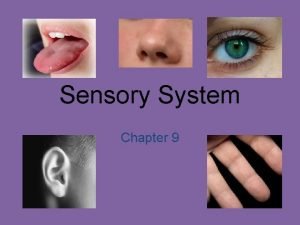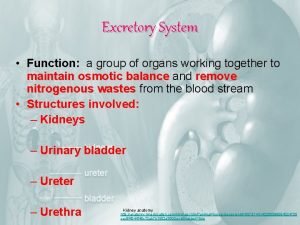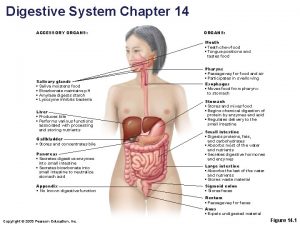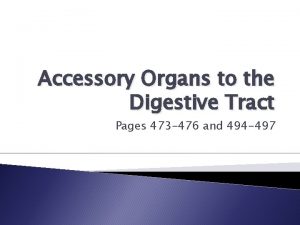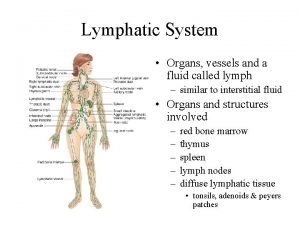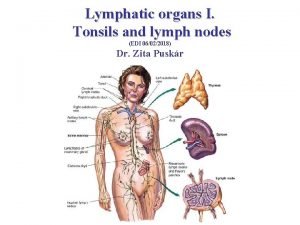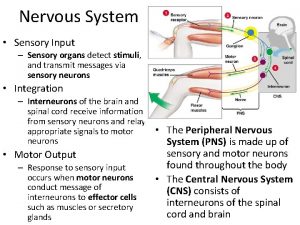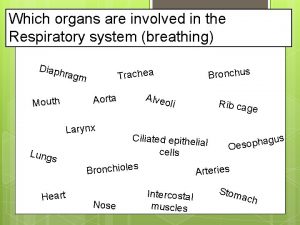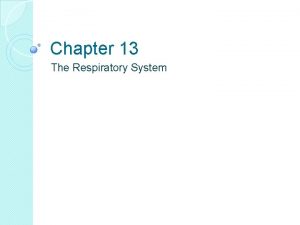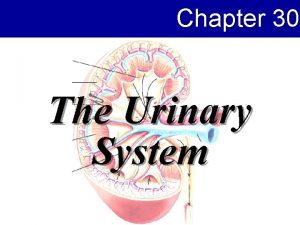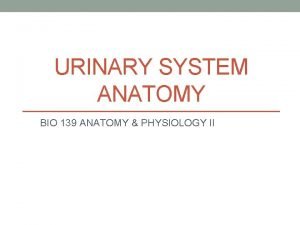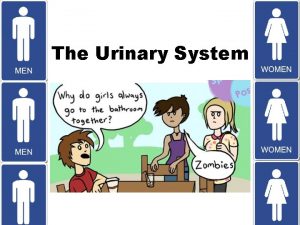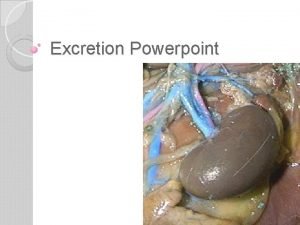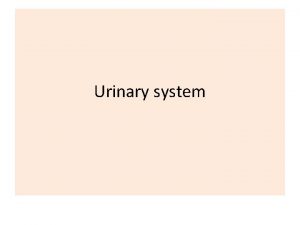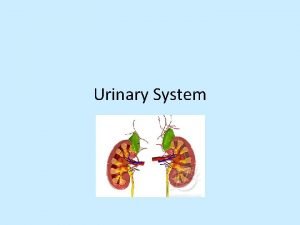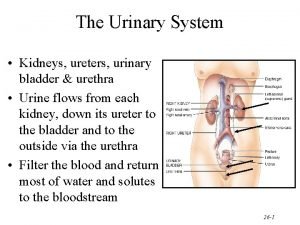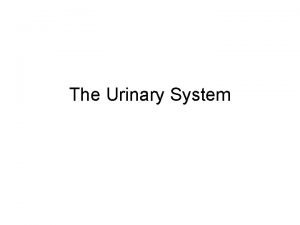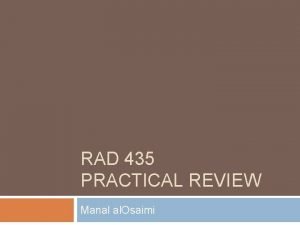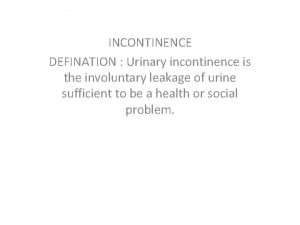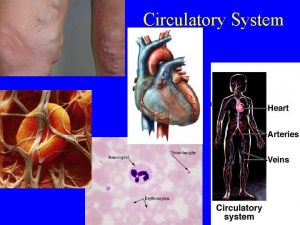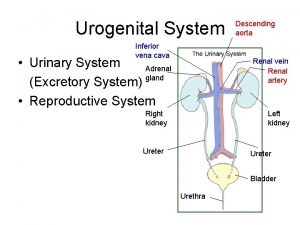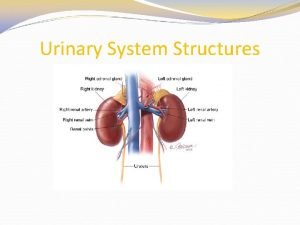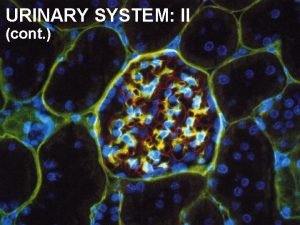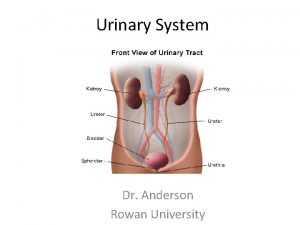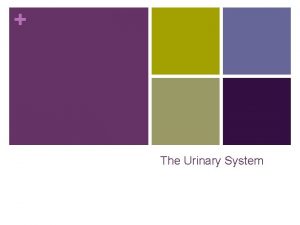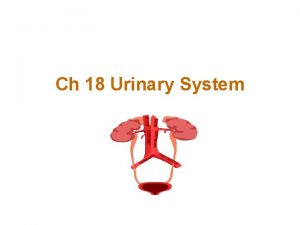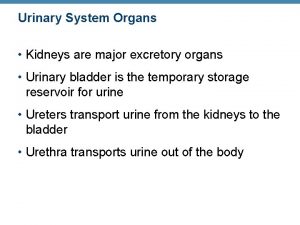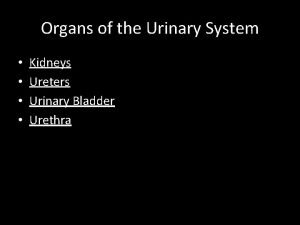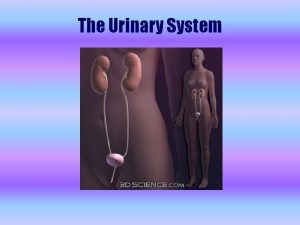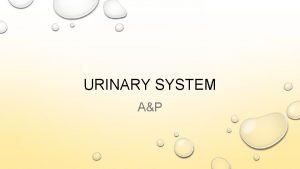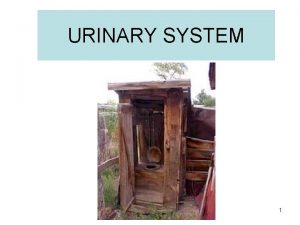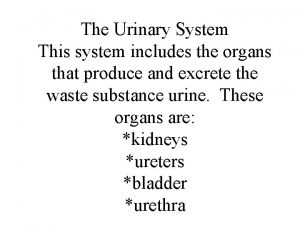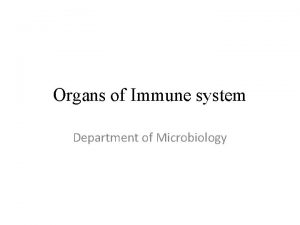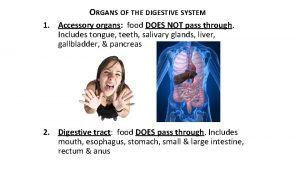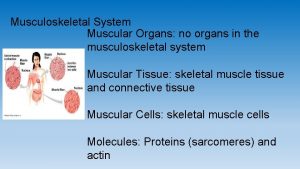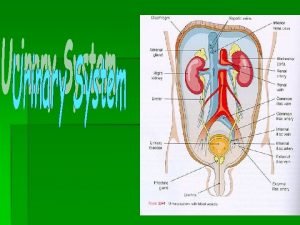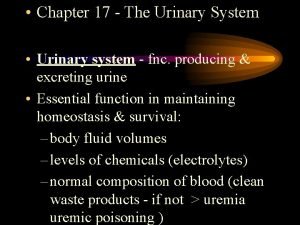Ch 18 Urinary System Urinary System Organs 1






































- Slides: 38

Ch 18 Urinary System

Urinary System • Organs 1. 2 Kidneys 2. 2 Ureters 3. Urinary bladder 4. Urethra

Urinary System

Anatomy of Urinary System

Urinary System • Functions 1. Excrete waste products (urine) 2. Regulate blood volume, electrolytes, blood p. H (acid-base balance), tissue fluid 3. RBC production 4. Vit. D synthesis-kidneys along with skin and liver

Kidneys • Structure 1. Bean-shaped 2. Retroperitoneal (upper abdominal c. , on either side of vertebral column) 3. Each covered by renal fascia (renal capsule) 4. Medial side indentation called hilus (site where blood vessels, nerves & ureters merge)


Kidneys • Internal Structure 1. 2 tissue portion renal cortex – outer renal medulla – inner 2. Renal medulla divided 3 areas: - renal pyramids - renal pelvis - calyces

renal columns renal cortex renal pyramids renal calyces renal vein renal artery renal pelvis ureter

Kidneys • Internal Structure 3. Nephron = functional unit of kidney, consist of 2 major components - renal corpuscle - renal tubules

Kidneys • Nephron Structure 1. Renal corpuscle = consists of - glomerulus (tuft of capillaries- porous) - renal capsule surrounds glomerulus (very porous) - also called Bowman’s capsule

Kidneys • Nephron Structure 2. Renal tubules = continuous w/ Bowman’s capsule Tubules listed in order: - proximal convoluted tubule - loop of Henle (ascending & descending limbs) - distal convoluted tubule - collecting duct

Nephron-functional unit of kidney


Renal Corpusle Bowman’s capsule is the enlarged end of the nephron. Outer layer simple squamous epi and inner layer podocytes Blood flows into the glomerulus from the afferent arteriole and leaves the glomerulus through the efferent arteriole

Filtration membrane Podocytes of Bowman’s capsule surround the porous glomerular capillaries Filtration Membrane consists of capillary endothelium, basement membrane and podocytes

Kidneys • Nephron Structure 3. Peritubular capillaries = surround renal tubules to secrete/reabsorb materials to/from tubules

Blood flow Circulation through arteries capillaries and veins of the kidney and nephrons

Kidneys • Formation of urine: 1. 3 major processes - glomerular filtration - tubular reabsorption - tubular secretion

Urine formation 1. filtration- movement across filtation membrane into bowman’s capsule 2. Solutes are reabsorbed across the wall of the nephron by active transport and cotransport, water follows 3. Solutes are secreted across the wall of the nephron into the filtrate


Kidneys • Formation of urine: 1. Glomerular filtration= b. p. forces plasma, dissolved substances wastes and small molecules out glomerulus to renal capsule = is now called filtrate about 19 -20% of of the tt volume of blood that flows through the glomerular capillaries (no blood cells) – Rate = about 100 -125 ml/min (180 L/ day)

Kidneys • Formation of urine: 2. Tubular reabsorption = takes place between renal tubules & peritubular capillaries. Average urine output = 1 -2 L/day. • 99% filtrate is reabsorbed back into blood of peritubular capillaries 1 % becomes urine • Proteins, AA, glucose, fructose, Na+, K+, Ca++, HCO 3, Cl- are all reabsorbed

About 65 % of filtrate reabsorbed in proximal tubule, 15% in descending limb and 19% in distal tubule and collecting duct

Water reabsorption from filtrate

Kidneys • Formation of urine: 3. Tubular secretion = substances H+ wastes/ammonia, medications, are actively secreted from blood of peritubular capillaries into renal tubules


Regulation of Na+ & water in blood and other ECF Inc osmolality affects hypothalamic neurons and decreased BP affects baroreceptors inc water reabsorption Dec BP A II aldosterone inc BP Inc BP in the rt atrium inc secretion of atrial natriuretic hormone inc Na+ excretion and water loss in the form of urine

Kidneys • Elimination of urine: 1. Involves ureters, urinary bladder & urethra – ureters = muscular tube extends from hilus to posterior inferior portion of urinary bladder, peristaltic movements propel urine to bladder

Ureters and Bladder

Kidneys • Elimination of urine: 2. urinary bladder – trigone shaped muscular sac • women below uterus • men above prostate • temporarily stores urine (400 ml)

Urinary bladder

Kidneys • Elimination of urine: 3. urethra – tube carries urine from bladder to exterior. – women = 1 -1. 5 in – men = 7 -8 in. & also extends through prostate where it carries semen - micturition – expulsion of urine from urinary bladder

ureters Urinary bladder urethra

Hormonal regulation of blood volume and effects on urine volume and concentration

Regulation of K+ levels in blood and ECF

Regulation of Calcium Ions in the Blood

Regulation of Acid-Base Balance
 Red and white blood cells difference
Red and white blood cells difference Sensory system organs
Sensory system organs Describe the human excretory system
Describe the human excretory system Figure 14-1 digestive system
Figure 14-1 digestive system Accessory organs of the digestive system
Accessory organs of the digestive system Digestive accessory organs
Digestive accessory organs Formation of lymph
Formation of lymph Lymphatic tissue
Lymphatic tissue Function of lymphatic system
Function of lymphatic system Organs of the sensory system
Organs of the sensory system Which organs are involved in respiratory system
Which organs are involved in respiratory system Chapter 13 respiratory system
Chapter 13 respiratory system Chapter 16 endocrine system
Chapter 16 endocrine system Introduction of urinary system
Introduction of urinary system Chapter 15 urinary system
Chapter 15 urinary system Hyperproteinuria definition
Hyperproteinuria definition Interesting facts about the integumentary system
Interesting facts about the integumentary system Bladder fetal pig
Bladder fetal pig Chapter 30 the urinary system
Chapter 30 the urinary system Chapter 15 the urinary system figure 15-3
Chapter 15 the urinary system figure 15-3 Chapter 20 urinary/excretory system
Chapter 20 urinary/excretory system Urinary system model
Urinary system model Urinary system model
Urinary system model Placoid scales definition
Placoid scales definition Urinary system powerpoint
Urinary system powerpoint Proximal convoluted tubule histology
Proximal convoluted tubule histology Urinary system pathway
Urinary system pathway Nephron urinary system
Nephron urinary system Nephron urinary system
Nephron urinary system Hysterosalpingography
Hysterosalpingography Defination of urinary system
Defination of urinary system Excretory system
Excretory system External anatomy of rat
External anatomy of rat Rat urinary system
Rat urinary system Vena cava excretory system
Vena cava excretory system Kidneys location and structure figure 15-1
Kidneys location and structure figure 15-1 Macula densa cells location
Macula densa cells location Renal tubule
Renal tubule Urinary system
Urinary system

